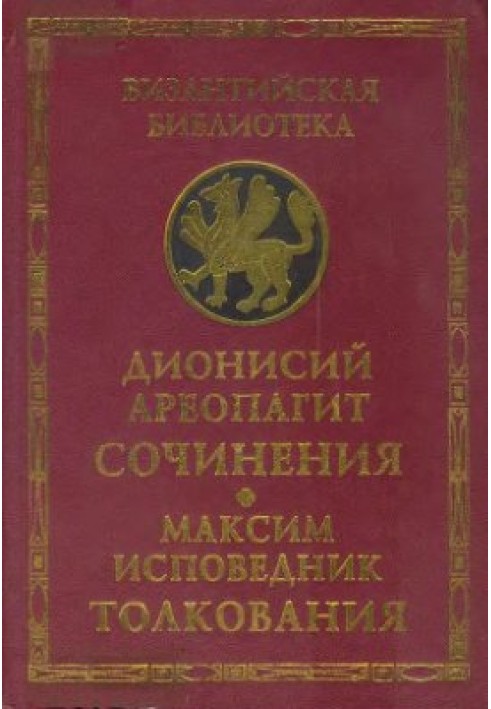Essays. Interpretations of Maximus the Confessor
 Instant download
Instant download
after payment (24/7)
 Wide range of formats
Wide range of formats
(for all gadgets)
 Full book
Full book
(including for Apple and Android)
The book contains a Corpus of works inscribed with the name of Dionysius the Areopagite, a disciple of the Apostle Paul, with comments that he provided them with in the 7th century. Byzantine theologian St. Maxim the Confessor. Modern science dates these mysterious theological and philosophical works to the end of the 5th century. In this form, the Corpus had a tremendous influence on the entire Christian world, both eastern and western, both in the Middle Ages and during the Renaissance. The Corpus was translated into Slavic in 1371, and spread to Rus' at the turn of the 14th–15th centuries, during the period of the “second South Slavic influence” These works opened up the world of “high” Hellenic speculation to Russian readers and theologians, and had a serious impact on the theological thinking and culture of ancient Rus'. Their influence is felt in socio-political concepts of the 16th century, in many works of ancient Russian literature, in iconographic subjects. Without the works of Dionysius the Areopagite, it is impossible to understand the spiritual universe of ancient Russia. In a modern Russian translation, in parallel with the Greek original, the Corpus as a whole is published for the first time. The book is intended for theologians, philosophers, historians of culture and literature, ancient scholars, Russian scholars, and all readers interested in the enduring values of world culture. CONTENTS: From the translator of Saint Maximus, a preface to the works of Saint Dionysius ABOUT THE HEAVENLY HIERARCHY Chapter 1. That every divine illumination, by the goodness of God, is varied in that which Providence takes care of, the passing not only remains simple, but also unites the illuminated Chapter 2. About what is divine and heavenly appropriately revealed by symbols that are not similar to it. Chapter 3. What is hierarchy and what is the use of hierarchy? Chapter 4. What does the name of angels indicate? Chapter 5. Why are all heavenly beings collectively called angels? Chapter 6. What is the first order of heavenly beings, what is the middle and what is the last? Chapter 7. About the seraphim , cherubim, thrones and the first, their hierarchy Chapter 8. About the dominions, powers, authorities and their middle hierarchy Chapter 9. About the principles, archangels and angels, and the last, their hierarchy Chapter 10. Repetition and reduction of what has been said regarding the angelic deanery Chapter 11 Why are all heavenly beings called the same by heavenly powers? Chapter 12. Why do people call their leaders angels? Chapter 13. Why is it said that the prophet Isaiah was purified by the seraphim? Chapter 14. What does it mean? the number of angels reported by tradition Chapter 15. What forms do the images of angelic powers have, what does fire-likeness mean, what is human-likeness, what are the eyes, what are the nostrils, what are the ears, what are the lips and other things characteristic of the head ABOUT THE DIVINE NAMES Chapter 1. What is the purpose of the essay and what is the tradition about the divine names. 207 Chapter 2. About united and separate theology, and what is divine union and separation Chapter 3. What is the power of prayer, about blessed Hierotheos, about reverence and about theological writing Chapter 4. About the names “Good”, “Light”, “Beauty”. ”, “Love”, “Ecstasy”, “Zeal”, that evil does not exist, that it is not from the Existing and not among the Existing Chapter 5. About the name “Existing”, it also contains about the prototypes Chapter 6. About the name “Life” Chapter 7. About the names “Wisdom”, “Mind”, “Word”, “Truth”, “Faith” Chapter 8 About the names “Strength”, “Justice”, “Salvation”, “Deliverance”; it also talks about inequalityChapter 9. About the names “Great”, “Small”, “Same”, “Different”, “Similar”, “Dissimilar”, “Rest”, “Movement”, “Equality”Chapter 10. About names “Almighty” and “Ancient Day”, and here about eternity and time Chapter 11. About the name “World”, about what “Being-in-itself” means, what “Life-in-itself” is ", "Strength in itself" and other things thus expressed Chapter 12. About the names "Holy of Holies", "King of Kings", "Lord of Lords", "God of Gods" Chapter 13. About the names "Perfect" and " One” ABOUT THE CHURCH HIERARCHY Chapter 1. What is the tradition about the church hierarchy and what is its purpose Chapter 2. About what is accomplished during enlightenment Chapter 3. About what is accomplished in the assembly Chapter 4. About how the world is accomplished and what is accomplished through itsChapter 5. About the priestly [rites, their capabilities and actions,] accomplishmentsChapter 6. About the rites performedChapter 7. About the things performed over the dead ABOUT MYSTICAL THEOLOGYChapter 1. What is divine darknessChapter 2. How it is appropriate to ascend to the universal and all-transcending Cause and chant ItChapter 3. What is cataphatic theology and what is apophatic? Chapter 4. What is nothing of the sensible, surpassing it, is the Cause of everything sensible. Chapter 5. What is nothing of the mental, surpassing it, is the Cause of everything mental. To the same Epistle 5. Dorotheus the liturgist Epistle 6. Sopater the priest Epistle 7. Polycarp the hierarch Epistle 8. Dimophilus the minister Epistle 9. Titus the hierarch Epistle 10. John the Theologian
Data sheet
- Name of the Author
- Дионисий Ареопагит
- Language
- Russian
- Translator
- Гелиан Михайлович Прохоров














